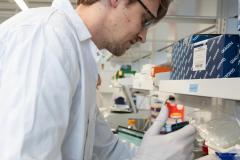A new study, published this week in Science Translational Medicine, further refines a potential new treatment that can prevent transplant rejection in kids and adults without leaving them vulnerable to infection.
The treatment, which was initially developed by Dr. Megan Levings’ research team, involves genetically engineering specialized immune cells called T regulatory cells (T regs) so that they can dampen down the immune system if it mounts an overzealous response to transplanted tissues.
“The problem that patients face when receiving a donor organ is that their immune system is designed to recognize cells or tissues from another person as dangerous and attack them,”
says senior author Dr. Levings. “The current solution to this problem is to use immunosuppressive drugs, but these medications can leave patients more vulnerable to subsequent infections or cancer.”
T regs have a natural ability to instruct the rest of the immune system to tone down or ignore a particular molecule. By inserting a gene into these cells, researchers can replace their targeting receptor with a designed one called CAR (chimeric antigen receptor). This new CAR can be tailored to recognize the donated tissue, and then orchestrate the rest of the immune system to leave it alone.
To boost these CAR T regs’ ability to instruct other immune cells, the researchers in this study also tested additional genes that can further amplify this message to stand down.
"There are an enormous variety of cellular signals that collectively act as a circuit board to instruct immune cells to speed up, slow down, last longer or proliferate,” says Dr. Levings. “So we created 10 different types of CAR T regs and each one activated a different signal - effectively flicking different switches on the circuit board.”
The research team then analyzed how well these different versions of CAR T regs performed using an animal model of graft versus host disease, a harmful immune response that can happen in bone marrow transplantation, as well as testing their ability to regulate immune signals.
The group found that CAR Tregs that specifically activated a signal called CD28 (which is required for T cell activation and survival) was the most effective at protecting the host from a harmful immune response.
“This method of engineering immune cells is still in the early phases of development, and the scientific community has only just scratched the surface of the various ways we can manipulate these cells to give a desired response,” said Dr. Levings. “To ensure we are pursuing the right path, we systematically investigated several potential signals to ensure we’re developing the best possible therapy for these patients."
"Once we’re sure that we have designed the strongest possible candidate, we can pave the way for a future in which kids and adults needing organ transplants can receive them safely and without the need for immunosuppressive drugs and the resulting complications.”
Dr. Levings is an investigator and head of the Childhood Disease Research Theme at BC Children’s as well as a professor in UBC’s Department of Surgery and School of Biomedical Engineering.




